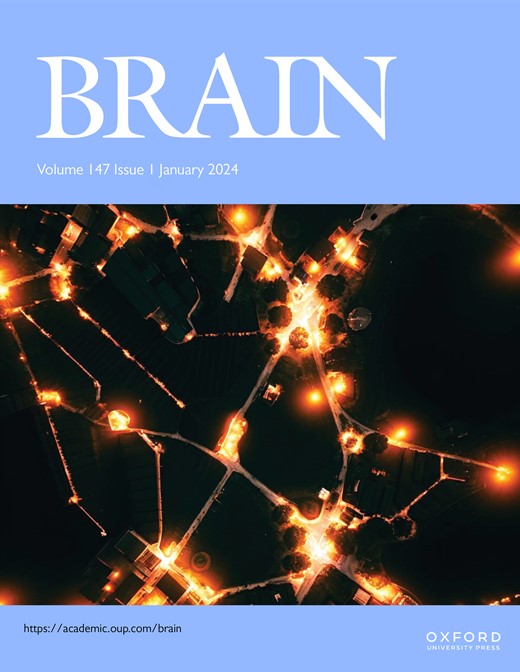手术白质破坏导致未切除的人脑下游萎缩
IF 11.7
1区 医学
Q1 CLINICAL NEUROLOGY
引用次数: 0
摘要
切除性神经外科手术是许多神经系统疾病的基础治疗。尽管传统上被视为局部手术,但越来越多的先进磁共振成像(MRI)证据表明,未切除的解剖结构也可能在手术后退化。局部组织切除与这些术后改变之间的关系至今仍是推测性的。在这里,我们研究了一种假设,即手术保存的灰质和白质的退行性改变是由跨神经元变性介导的,这是一种由于轴突输入丢失而导致的完整神经元群的退化。使用专为外科影像数据纵向分析量身定制的强大弥散加权和t1加权MRI框架,我们评估了一系列接受癫痫切除手术的患者支持这一机制的证据;即前颞叶切除术(ATL, n=31)或选择性杏仁核海马切除术(SAHE, n=28)。我们绘制了跨神经元变性解剖区域的三个关键方面:1)手术切除的白质丢失;2)皮质厚度纵向变化;3)未切除白质纵向萎缩。使用混合效应模型,我们探索了支持退化顺序进展的证据,其中切除的白质损失导致连接的灰质及其白质连接的下游萎缩。ATL和SAHE均导致广泛的与切除相关的白质损失,主要连接到靠近切除的同侧区域。我们还发现这些区域的皮质厚度明显减少,同侧半球的白质也广泛萎缩。这些术后改变与切除相关的白质损失密切相关,每10倍的连接损失导致皮层厚度减少3.4%,下游通路密度减少7.2%。除了退化效应之外,我们还展示了如果不能正确地根据这些数据定制纵向图像处理,可能会对广泛的结构网络重组产生误导性的证据,我们更强大的方法表明,切除后宏观尺度可塑性的能力有限。本文章由计算机程序翻译,如有差异,请以英文原文为准。
Surgical white matter disruption leads to downstream atrophy in the non-resected human brain
Resective neurosurgery is a cornerstone treatment for many neurological conditions. Although traditionally viewed as localised procedure, increasing evidence from advanced magnetic resonance imaging (MRI) shows that also non-resected anatomy can degenerate following surgery. The relationship between local tissue removal and these postoperative changes remains thus far speculative. Here, we investigate the hypothesis that degenerative changes to surgically preserved grey and white matter are mediated by transneuronal degeneration, a deterioration of intact neuronal populations due to lost axonal input. Using a robust diffusion-weighted and T1-weighted MRI framework specifically tailored for longitudinal analysis of surgical image data, we evaluated evidence to support this mechanism in a series of patients undergoing resective surgery for epilepsy; namely anterior temporal lobectomy (ATL, n=31) or selective amygdalohippocampectomy (SAHE, n=28). We mapped three key aspects of transneuronal degeneration for anatomical regions: 1) loss of surgically resected white matter; 2) longitudinal change in cortical thickness; 3) longitudinal atrophy of non-resected white matter. Using mixed effects models, we explored the evidence in support of a sequential progression of degeneration, where loss of resected white matter leads to downstream atrophy of connected grey matter and the white matter connections thereof. Both ATL and SAHE resulted in extensive resection-related white matter losses, predominately connecting to ipsilateral regions close to resection. We also found pronounced cortical thickness decreases in these regions, as well as extensive white matter atrophy across the ipsilateral hemisphere. These postsurgical alterations were closely associated with resection-related white matter losses, with every 10-fold loss of connections leading to a 3.4% decrease in cortical thickness and a 7.2% decrease in density of downstream pathways. Beyond degenerative effects, we also demonstrate how failure to properly tailor longitudinal image processing to such data can yield misleading evidence for extensive structural network reorganisation, with our more robust approach indicating limited capacity for macroscale plasticity post-resection.
求助全文
通过发布文献求助,成功后即可免费获取论文全文。
去求助
来源期刊

Brain
医学-临床神经学
CiteScore
20.30
自引率
4.10%
发文量
458
审稿时长
3-6 weeks
期刊介绍:
Brain, a journal focused on clinical neurology and translational neuroscience, has been publishing landmark papers since 1878. The journal aims to expand its scope by including studies that shed light on disease mechanisms and conducting innovative clinical trials for brain disorders. With a wide range of topics covered, the Editorial Board represents the international readership and diverse coverage of the journal. Accepted articles are promptly posted online, typically within a few weeks of acceptance. As of 2022, Brain holds an impressive impact factor of 14.5, according to the Journal Citation Reports.
 求助内容:
求助内容: 应助结果提醒方式:
应助结果提醒方式:


